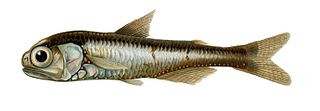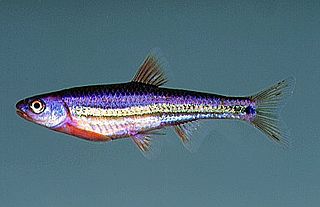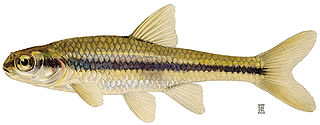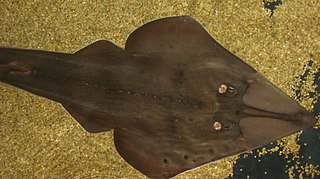Species
The recognized species in this genus are: [1]
- Scopelengys clarkei J. L. Butler & Ahlstrom, 1976
- Scopelengys tristis Alcock, 1890 (Pacific blackchin)

Alfred William Alcock, CIE was a British physician, naturalist, and carcinologist.
| Scopelengys | |
|---|---|
| Scientific classification | |
| Kingdom: | Animalia |
| Phylum: | Chordata |
| Class: | Actinopterygii |
| Order: | Myctophiformes |
| Family: | Neoscopelidae |
| Genus: | Scopelengys Alcock, 1890 |
Scopelengys is a genus of blackchins.
The recognized species in this genus are: [1]

Alfred William Alcock, CIE was a British physician, naturalist, and carcinologist.
A genus is a taxonomic rank used in the biological classification of living and fossil organisms, as well as viruses, in biology. In the hierarchy of biological classification, genus comes above species and below family. In binomial nomenclature, the genus name forms the first part of the binomial species name for each species within the genus.
Binomial nomenclature, also called binominal nomenclature or binary nomenclature, is a formal system of naming species of living things by giving each a name composed of two parts, both of which use Latin grammatical forms, although they can be based on words from other languages. Such a name is called a binomial name, a binomen, binominal name or a scientific name; more informally it is also called a Latin name. The first part of the name – the generic name – identifies the genus to which the species belongs, while the second part – the specific name or specific epithet – identifies the species within the genus. For example, humans belong to the genus Homo and within this genus to the species Homo sapiens. Tyrannosaurus rex is probably the most widely known binomial. The formal introduction of this system of naming species is credited to Carl Linnaeus, effectively beginning with his work Species Plantarum in 1753. But Gaspard Bauhin, in as early as 1623, had introduced in his book Pinax theatri botanici many names of genera that were later adopted by Linnaeus.

In biology, a monotypic taxon is a taxonomic group (taxon) that contains only one immediately subordinate taxon.

The Myctophiformes are an order of ray-finned fishes consisting of two families of deep-sea marine fish, most notably the highly abundant lanternfishes (Myctophidae). The blackchins (Neoscopelidae) contain six species in three genera, while the bulk of the family belongs to the Myctophidae, with over 30 genera and some 252 species.

In zoological nomenclature, a type species is the species name with which the name of a genus or subgenus is considered to be permanently taxonomically associated, i.e., the species that contains the biological type specimen(s). A similar concept is used for suprageneric groups called a type genus.

Lanternfishes are small mesopelagic fish of the large family Myctophidae. One of two families in the order Myctophiformes, the Myctophidae are represented by 246 species in 33 genera, and are found in oceans worldwide. They are aptly named after their conspicuous use of bioluminescence. Their sister family, the Neoscopelidae, are much fewer in number but superficially very similar; at least one neoscopelid shares the common name 'lanternfish': the large-scaled lantern fish, Neoscopelus macrolepidotus.

Sarotherodon is a genus of tilapiine cichlids endemic to Africa and the Middle East. A few species from this genus have been introduced far outside their native range, and are important in aquaculture. They mainly inhabit fresh and brackish water, but a few can live in salt water. Members of this genus, as well as those of the genera Tilapia and Oreochromis, share the common name "tilapia".

Notropis is a genus of freshwater fish in the family Cyprinidae. They are known commonly as eastern shiners. They are native to North America, and are the continent's second largest genus.

The bridle shiner is a member of the minnow family (Cyprinidae). This species has been identified as being of Special Concern by the Committee on the Status of Endangered Wildlife in Canada (COSEWIC).

In biological classification, taxonomic rank is the relative level of a group of organisms in a taxonomic hierarchy. Examples of taxonomic ranks are species, genus, family, order, class, phylum, kingdom, domain, etc.

The Neoscopelidae are a small family of deep-sea fish closely related to the lanternfish. They are found in tropical and subtropical marine waters worldwide.
The blackchin shiner is an abundant North American species of freshwater fish from the family Cyprinidae. Described by Edward Drinker Cope in 1865, it is not a well-known species. It is a close relative of the blacknose shiner. Chiefly occurring now in the Great Lakes and occasionally in upper Mississippi River drainages, the blackchin once ranged commonly as far south as Illinois and Ohio. This fish resides over sandy bottoms in cool waters that provide a lot of cover for the small minnow. Omnivorous, it eats worms and small arthropods as well as plant material. Blackchin shiners are unique because of their anatomical features, such as the black coloring, the incomplete lateral line, and a distinctive dental arrangement.
Psednos is a genus of snailfishes found in all the world's oceans.

The common guitarfish is a species of cartilaginous fish in the family Rhinobatidae. It is native to the eastern Atlantic Ocean and the Mediterranean Sea. It is a bottom-dwelling fish feeding on crustaceans, other invertebrates and fish. The females give birth to live young. Its lifestyle makes it vulnerable to trawling and other fishing methods, populations seem to be declining and it has disappeared from parts of its range. The International Union for Conservation of Nature has assessed its conservation status as being "endangered".

Glaucostegus, also known as giant guitarfishes, is a genus of large Indo-Pacific rays, with a single species, G. cemiculus, in the East Atlantic and Mediterranean. They were formerly classified in the family Rhinobatidae but are now recognized as a distinct family, Glaucostegidae.
Bathylagoides is a genus of deep-sea smelts.

Neoscopelus is a genus of blackchins.
Solivomer arenidens is a species of blackchin only known from the waters around the Philippines where they are known from around 1,413 metres (4,636 ft).

The blackchin tilapia is a species of cichlid native to coastal west Africa. It is a paternal mouthbrooder which has been introduced to Asia and North America.

The blackchin guitarfish is a species of cartilaginous fish in the family Rhinobatidae. It is native to the eastern Atlantic Ocean and the Mediterranean Sea. It is a bottom-dwelling fish feeding on crustaceans, other invertebrates and fish. The females give birth to live young. Its lifestyle makes it vulnerable to trawling and other fishing methods, populations seem to be declining and it is subject to intensive fishing pressure, with its fins being sold into the Asian market. The International Union for Conservation of Nature has assessed its conservation status as being "endangered".
| This Myctophiformes -related article is a stub. You can help Wikipedia by expanding it. |